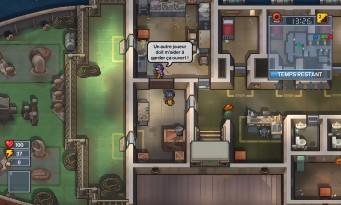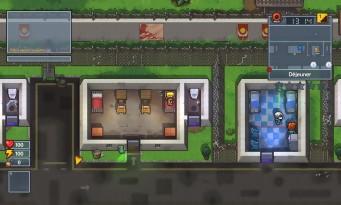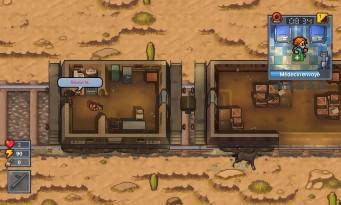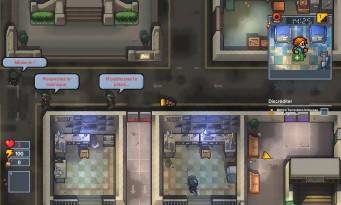 Unlike a stealth game, The Escapists summoned us to exfiltrate from various more or less well-guarded prisons. This second part takes up this audacious and uncompromising principle. Because as a prisoner, you cannot easily access weapons, are under constant surveillance, and have fairly limited freedom of movement. Under these conditions, how to get out of prison hell? Paradoxically, you have to start by doing nothing. Or more precisely by scrupulously following the routines imposed on the prisoners. You will have to answer the morning call, then go to the common room for breakfast, stop by the recruiting office to look for work, go to the gym when you are told to, take a shower in same time as the other prisoners, and so on until the lights go out, when you will have to go to your cell to sleep…until the morning roll call sounds the following day. By doing so, you'll be seen as a model prisoner, won't draw too much attention to yourself, and guards like your fellow inmates will like you.
Unlike a stealth game, The Escapists summoned us to exfiltrate from various more or less well-guarded prisons. This second part takes up this audacious and uncompromising principle. Because as a prisoner, you cannot easily access weapons, are under constant surveillance, and have fairly limited freedom of movement. Under these conditions, how to get out of prison hell? Paradoxically, you have to start by doing nothing. Or more precisely by scrupulously following the routines imposed on the prisoners. You will have to answer the morning call, then go to the common room for breakfast, stop by the recruiting office to look for work, go to the gym when you are told to, take a shower in same time as the other prisoners, and so on until the lights go out, when you will have to go to your cell to sleep…until the morning roll call sounds the following day. By doing so, you'll be seen as a model prisoner, won't draw too much attention to yourself, and guards like your fellow inmates will like you.
As for the libraries, they allow you to increase the intelligence, necessary to master certain crafting recipes. Tying sheets makes a rope, combining soap and a sock makes a makeshift blunt weapon, two crowbars and duct tape will result in a grappling hook, and more.
 But fortunately, this daily pattern leaves some opportunities to mount a worthy escape plan. Thus, training at the gym allows you to increase your strength (useful for performing certain actions and to increase the damage inflicted when hitting) or your form (which limits the loss of endurance induced by most physical actions ). As for the libraries, they allow you to increase the intelligence, necessary to master certain crafting recipes. Because, yes, craftsmanship plays a key role in the game. You will need to take advantage of the few rest periods in your daily schedule to find as many objects as possible, in order to make the weapons and tools necessary for your escape. Tying sheets makes a rope, combining soap and a sock makes a makeshift blunt weapon, two crowbars and duct tape will result in a grappling hook, and more. There are over a hundred craftable items, including fake keys, cakes, nunchucks, fake flowers, stun batons, contraband pouches, wire cutters, guardian outfits, and more. still other things.
But fortunately, this daily pattern leaves some opportunities to mount a worthy escape plan. Thus, training at the gym allows you to increase your strength (useful for performing certain actions and to increase the damage inflicted when hitting) or your form (which limits the loss of endurance induced by most physical actions ). As for the libraries, they allow you to increase the intelligence, necessary to master certain crafting recipes. Because, yes, craftsmanship plays a key role in the game. You will need to take advantage of the few rest periods in your daily schedule to find as many objects as possible, in order to make the weapons and tools necessary for your escape. Tying sheets makes a rope, combining soap and a sock makes a makeshift blunt weapon, two crowbars and duct tape will result in a grappling hook, and more. There are over a hundred craftable items, including fake keys, cakes, nunchucks, fake flowers, stun batons, contraband pouches, wire cutters, guardian outfits, and more. still other things.
THE DOORS OF THE PENITENTIARY
 To obtain the objects, the easiest way is to search the offices of the other inmates, taking care that no one notices. In a more honest way, you can also buy certain items from prisoner vendors. To get money, just talk to the staff at the recruiting office or, even better, take one of the few jobs available if you have high enough stats. And to supplement your salary, there's nothing like completing quests. Many inmates need services, whether it's making a delivery for them, finding a lost item, or even stashing a compromising item in another prisoner's cell. All this while respecting the daily routines, so as not to increase the security level of the prison and not to be sent to solitary confinement, even if a small session of peeling potatoes will then allow you to get by quickly. Thus, day after day, you will have more and more money and objects, therefore possibilities to make you beautiful. It is also important to take advantage of your free time slots to observe the movements of the guards and study the geography of the place as much as possible. The prisons are indeed very large, and are spread over several levels, some being devoted to basements and ventilation ducts, in order to give you ever more access routes to freedom.
To obtain the objects, the easiest way is to search the offices of the other inmates, taking care that no one notices. In a more honest way, you can also buy certain items from prisoner vendors. To get money, just talk to the staff at the recruiting office or, even better, take one of the few jobs available if you have high enough stats. And to supplement your salary, there's nothing like completing quests. Many inmates need services, whether it's making a delivery for them, finding a lost item, or even stashing a compromising item in another prisoner's cell. All this while respecting the daily routines, so as not to increase the security level of the prison and not to be sent to solitary confinement, even if a small session of peeling potatoes will then allow you to get by quickly. Thus, day after day, you will have more and more money and objects, therefore possibilities to make you beautiful. It is also important to take advantage of your free time slots to observe the movements of the guards and study the geography of the place as much as possible. The prisons are indeed very large, and are spread over several levels, some being devoted to basements and ventilation ducts, in order to give you ever more access routes to freedom.
Good news, The Escapists 2 manages to offer sufficiently varied "themed prisons" to avoid too strong an impression of repetition from one prison enclosure to another. Fort of Far West, drilling platform converted into a prison, Siberian camp, military base inspired by Area 51 and even space station thus act as playgrounds.
 In addition to the short tutorial prison, the game offers ten independent levels, which guarantees dozens and dozens of hours of play. Good news, The Escapists 2 manages to offer "themed prisons" varied enough to avoid a too strong an impression of repetition from one prison enclosure to another. A Far West fort, a drilling rig converted into a prison, a Siberian camp, a military base inspired by Area 51 and even a space station serve as playgrounds. This new component also introduces the concept of mobile prisons, a story of vary the pleasures a little more. You will therefore have to escape from a train (for example by jumping on a horse, attracted using a fake carrot), leaving a warship (fixing the jet-ski located at the back seems to be a good idea) or force a plane to land. The game also scores points thanks to the introduction of a very nice cooperative mode, certain means of escape being accessible only when playing with several people. It works on a drop-in drop-out principle, which makes it possible to find companions in misfortune instantly. A competitive mode is also available, but it is more anecdotal because it boils down to a simple speed race and is devoid of a lot of features (no routines, no quests, free items from vendors, etc.). Let's quickly make a small return to the single player mode to talk about a welcome refinement: it is possible to customize the appearance and name of each of the guards and inmates of each level. It could be seen as a simple gimmick, but it is actually very useful for quickly finding specific characters once in the game. Admittedly, the cute pixelated 2D graphics prevent you from multiplying the customization options to infinity, but the hairstyles and accessories are still numerous enough to create caricatures of people close or known.
In addition to the short tutorial prison, the game offers ten independent levels, which guarantees dozens and dozens of hours of play. Good news, The Escapists 2 manages to offer "themed prisons" varied enough to avoid a too strong an impression of repetition from one prison enclosure to another. A Far West fort, a drilling rig converted into a prison, a Siberian camp, a military base inspired by Area 51 and even a space station serve as playgrounds. This new component also introduces the concept of mobile prisons, a story of vary the pleasures a little more. You will therefore have to escape from a train (for example by jumping on a horse, attracted using a fake carrot), leaving a warship (fixing the jet-ski located at the back seems to be a good idea) or force a plane to land. The game also scores points thanks to the introduction of a very nice cooperative mode, certain means of escape being accessible only when playing with several people. It works on a drop-in drop-out principle, which makes it possible to find companions in misfortune instantly. A competitive mode is also available, but it is more anecdotal because it boils down to a simple speed race and is devoid of a lot of features (no routines, no quests, free items from vendors, etc.). Let's quickly make a small return to the single player mode to talk about a welcome refinement: it is possible to customize the appearance and name of each of the guards and inmates of each level. It could be seen as a simple gimmick, but it is actually very useful for quickly finding specific characters once in the game. Admittedly, the cute pixelated 2D graphics prevent you from multiplying the customization options to infinity, but the hairstyles and accessories are still numerous enough to create caricatures of people close or known.
PRISON BREAK
 But now is the time to address the points that annoy because, no one is perfect, The Escapists 2 does not hit the mark every time. Thus, the quests given by the prisoners tend to be always somewhat the same, whether within the same game or from one level to another, while the means of escape sometimes seem very difficult to find. On the other hand, the concept of routines necessarily induces a dose of repetitiveness in the gameplay, which can easily put off the least patient players. Moreover, the general rhythm of each part is quite singular. The time that passes on the scale of a second for a minute is a little too fast to let us plan our escape as quietly as we would like but, at the same time, it does not prevent the actions of the routines to be a bit boring. We therefore constantly alternate between a feeling of urgency and slowness, which is quite disturbing. But this specificity is also part of the charm of the game, which clearly has the merit of thinking outside the box.
But now is the time to address the points that annoy because, no one is perfect, The Escapists 2 does not hit the mark every time. Thus, the quests given by the prisoners tend to be always somewhat the same, whether within the same game or from one level to another, while the means of escape sometimes seem very difficult to find. On the other hand, the concept of routines necessarily induces a dose of repetitiveness in the gameplay, which can easily put off the least patient players. Moreover, the general rhythm of each part is quite singular. The time that passes on the scale of a second for a minute is a little too fast to let us plan our escape as quietly as we would like but, at the same time, it does not prevent the actions of the routines to be a bit boring. We therefore constantly alternate between a feeling of urgency and slowness, which is quite disturbing. But this specificity is also part of the charm of the game, which clearly has the merit of thinking outside the box.


























